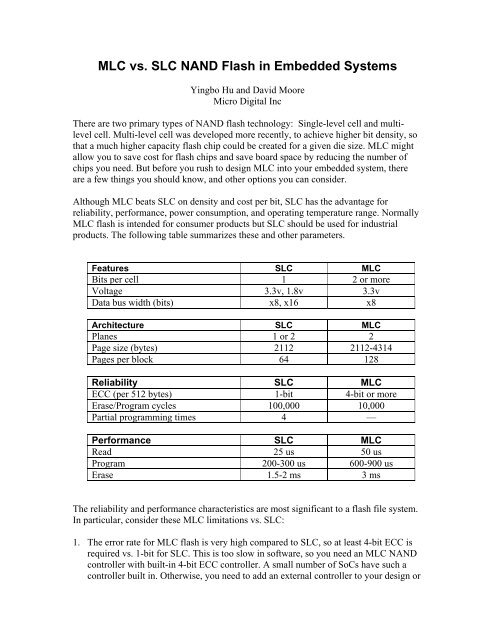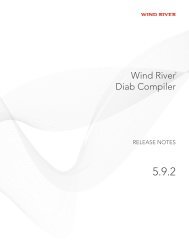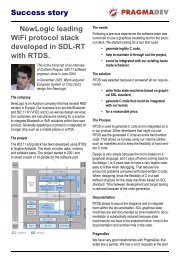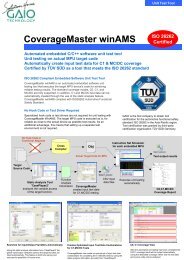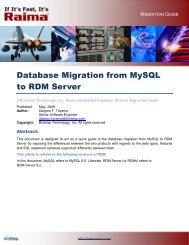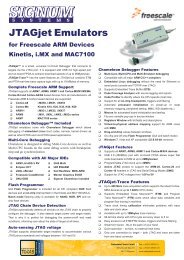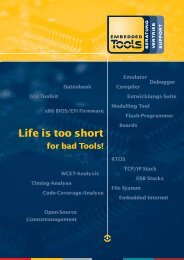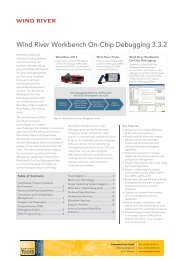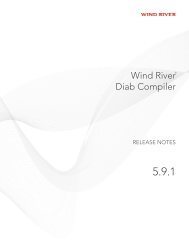MLC vs SLC NAND Flash in Embedded Systems - Embedded Tools ...
MLC vs SLC NAND Flash in Embedded Systems - Embedded Tools ...
MLC vs SLC NAND Flash in Embedded Systems - Embedded Tools ...
Create successful ePaper yourself
Turn your PDF publications into a flip-book with our unique Google optimized e-Paper software.
<strong>MLC</strong> <strong>vs</strong>. <strong>SLC</strong> <strong>NAND</strong> <strong>Flash</strong> <strong>in</strong> <strong>Embedded</strong> <strong>Systems</strong>Y<strong>in</strong>gbo Hu and David MooreMicro Digital IncThere are two primary types of <strong>NAND</strong> flash technology: S<strong>in</strong>gle-level cell and multilevelcell. Multi-level cell was developed more recently, to achieve higher bit density, sothat a much higher capacity flash chip could be created for a given die size. <strong>MLC</strong> mightallow you to save cost for flash chips and save board space by reduc<strong>in</strong>g the number ofchips you need. But before you rush to design <strong>MLC</strong> <strong>in</strong>to your embedded system, thereare a few th<strong>in</strong>gs you should know, and other options you can consider.Although <strong>MLC</strong> beats <strong>SLC</strong> on density and cost per bit, <strong>SLC</strong> has the advantage forreliability, performance, power consumption, and operat<strong>in</strong>g temperature range. Normally<strong>MLC</strong> flash is <strong>in</strong>tended for consumer products but <strong>SLC</strong> should be used for <strong>in</strong>dustrialproducts. The follow<strong>in</strong>g table summarizes these and other parameters.Features <strong>SLC</strong> <strong>MLC</strong>Bits per cell 1 2 or moreVoltage 3.3v, 1.8v 3.3vData bus width (bits) x8, x16 x8Architecture <strong>SLC</strong> <strong>MLC</strong>Planes 1 or 2 2Page size (bytes) 2112 2112-4314Pages per block 64 128Reliability <strong>SLC</strong> <strong>MLC</strong>ECC (per 512 bytes) 1-bit 4-bit or moreErase/Program cycles 100,000 10,000Partial programm<strong>in</strong>g times 4 —Performance <strong>SLC</strong> <strong>MLC</strong>Read 25 us 50 usProgram 200-300 us 600-900 usErase 1.5-2 ms 3 msThe reliability and performance characteristics are most significant to a flash file system.In particular, consider these <strong>MLC</strong> limitations <strong>vs</strong>. <strong>SLC</strong>:1. The error rate for <strong>MLC</strong> flash is very high compared to <strong>SLC</strong>, so at least 4-bit ECC isrequired <strong>vs</strong>. 1-bit for <strong>SLC</strong>. This is too slow <strong>in</strong> software, so you need an <strong>MLC</strong> <strong>NAND</strong>controller with built-<strong>in</strong> 4-bit ECC controller. A small number of SoCs have such acontroller built <strong>in</strong>. Otherwise, you need to add an external controller to your design or
purchase the IP to <strong>in</strong>clude <strong>in</strong> your ASIC or FPGA. The follow<strong>in</strong>g are a few ARMprocessors that have built-<strong>in</strong> ECC sufficient to support <strong>MLC</strong>:• NXP LPC3180/3250 processor has built-<strong>in</strong> <strong>MLC</strong> controller and Reed-Solomon ECC eng<strong>in</strong>e.• TI Dav<strong>in</strong>ci DM355 has built-<strong>in</strong> ECC eng<strong>in</strong>e for 1-bit and 4-bit ECC• TI OMAP 35xx processor has built-<strong>in</strong> ECC eng<strong>in</strong>e for 1-bit (Hamm<strong>in</strong>g) and4-bit (BCH)When ECC is calculated <strong>in</strong> hardware, performance is only m<strong>in</strong>imally reduced. In atest we did, write performance was reduced by only about 1.3%. By contrast, us<strong>in</strong>gsoftware to calculate ECC <strong>in</strong> our flash file system us<strong>in</strong>g software reducedperformance to a crawl:Without ECC1-bit ECC4-bit ECC600 KB/s300 KB/s5 KB/s (<strong>in</strong> software)Clearly 4-bit ECC <strong>in</strong> software is unacceptable. Even for a 512 MHz ARM11 weachieved only 30 KB/s. There are several algorithms for calculat<strong>in</strong>g 4-bit (or more)ECC. BCH (Bose, Ray-Chaudhuri, Hocquenghem) is popular because of its improvedefficiency over Reed-Solomon. However, even BCH needs too many microprocessorcycles. A 256 KB flash block has 256*1024*8 = 2 Mbit. The ECC calculations (donefor each 256 bytes) need 48 loops per bit, and for each bit it executes about 10<strong>in</strong>structions. So totally it needs 2M*48*10 (about a billion) <strong>in</strong>structions to calculateECC codes for one 256 KB flash block. Even on a 2 GHz W<strong>in</strong>dows PC, it needsabout 400-500 milliseconds.2. <strong>MLC</strong> supports only 1/10 the number of erase/program cycles of <strong>SLC</strong>. The flashmanagement software must have a carefully designed cache system that reduces thenumber of erase/program cycles. Also, the needs of the application must beconsidered. <strong>MLC</strong> is not suitable for applications that must do small frequent datawrite operations.3. No partial page programm<strong>in</strong>g. The flash management software cannot change orappend any new data to a page after data has been written to that page. <strong>Flash</strong> filesystem algorithms typically depend on this capability for efficiency and to reducewear on the flash. This is especially important consider<strong>in</strong>g the lower maximumerase/program cycle count.4. Programm<strong>in</strong>g must be sequential, from LSB to MSB. The flash management softwaremust make sure its algorithm will not write random pages with<strong>in</strong> a block.A flash file system designed for <strong>SLC</strong> flash is not likely to work on <strong>MLC</strong> flash, withoutsignificant modification. Depend<strong>in</strong>g on the algorithms used, it may be impossible withoutrewrit<strong>in</strong>g it. We have read this is true of JFFS2. In the case of our flash driver
(smx<strong>NAND</strong>, used by smxFFS and smxFS), relatively few modifications were needed.They were related to block table management and ECC. Fortunately, no changes wereneeded <strong>in</strong> other areas, such as its handl<strong>in</strong>g of data blocks. However, the modified driver isa little less efficient <strong>in</strong> its use of flash pages, caus<strong>in</strong>g a little more wear on the flash. Butif you choose a significantly larger <strong>MLC</strong> flash part than you need (which may be cheaperthan an <strong>SLC</strong> chip of the capacity you need), the static and dynamic wear level<strong>in</strong>g done bythe driver will spread the usage over the larger flash area, wear<strong>in</strong>g the cells to some<strong>in</strong>termediate and possibly acceptable level.Why Use <strong>MLC</strong> Then?Generally, we recommend us<strong>in</strong>g <strong>SLC</strong> <strong>in</strong> typical embedded systems. However, <strong>in</strong> veryhigh volume products (millions), it probably makes sense to consider <strong>MLC</strong>. For example,one customer of ours doesn’t care much about flash capacity; they just buy the cheapestflash chip. In their case, the <strong>MLC</strong> chip is $1.50 cheaper than the <strong>SLC</strong> chip, <strong>in</strong> the quantitythey buy, which would save them $millions.Other OptionsInstead of us<strong>in</strong>g raw <strong>NAND</strong> chips, you can use managed <strong>NAND</strong> devices, such as eMMC,eSD, i<strong>NAND</strong>, and microSD. These put the <strong>NAND</strong> flash software <strong>in</strong>to the device itself tohandle block management, ECC, wear level<strong>in</strong>g, etc. The system software does not needto know the details and can just access the flash disk as a normal block device. No flashdriver software is needed, only a file system with a driver for the device. This might be agood option if you want to use a lower-cost low-performance processor or one that has no<strong>MLC</strong> + ECC controller, or if you are develop<strong>in</strong>g a typical, low-volume embeddedproduct. Besides avoid<strong>in</strong>g the need for an <strong>MLC</strong> flash file system, this also reduces yoursystem’s requirements for RAM, ROM, and CPU power. Some such devices areremovable and some can be soldered to your board. Note that removable devices can beput fully with<strong>in</strong> your enclosure to prevent user removal.Helpful References1. <strong>MLC</strong> <strong>NAND</strong> <strong>Flash</strong> Web<strong>in</strong>arwww.micron.com/products/nand/mlc-web<strong>in</strong>ar2. <strong>SLC</strong> <strong>vs</strong>. <strong>MLC</strong>: An Analysis of <strong>Flash</strong> Memorywww.supertalent.com/datasheets/<strong>SLC</strong>_<strong>vs</strong>_<strong>MLC</strong>%20whitepaper.pdf3. Implement <strong>MLC</strong> <strong>NAND</strong> <strong>Flash</strong> for Cost-Effective, High Capacity Memorywww.data-io.com/pdf/<strong>NAND</strong>/M<strong>Systems</strong>/Implement<strong>in</strong>g_<strong>MLC</strong>_<strong>NAND</strong>_<strong>Flash</strong>.pdf4. Are <strong>MLC</strong> SSDs Ever Safe <strong>in</strong> Enterprise Apps?
http://www.storagesearch.com/ssd-slc-mlc-notes.html5. File System support on Multi Level Cell (<strong>MLC</strong>) flash <strong>in</strong> open sourcehttp://www.cel<strong>in</strong>ux.org/elc08_presentations/ELC2008%20Filesystem%20support%20on%20Multi%20Level%20Cell%20flash%20<strong>in</strong>%20open%20source.pptWhether you decide to use <strong>MLC</strong> or <strong>SLC</strong> <strong>in</strong> your system, please consider us<strong>in</strong>g one of ourfile systems, smxFFS or smxFS, which use the smx<strong>NAND</strong> flash driver.Contact us if you have questions about us<strong>in</strong>g <strong>NAND</strong> flash <strong>in</strong> your design.Y<strong>in</strong>gbo Hu, R&D <strong>Embedded</strong> Software Eng<strong>in</strong>eer, y<strong>in</strong>gbohu@smxrtos.comDavid Moore, Director of Development, davidm@smxrtos.comCopyright © 2009 Micro Digital Inc. All rights reserved. www.smxrtos.comsmx is a registered trademark of Micro Digital Inc. smx product names are trademarks of Micro Digital Inc.S:\Market<strong>in</strong>g\Articles\<strong>MLC</strong> <strong>vs</strong> <strong>SLC</strong> <strong>NAND</strong> <strong>Flash</strong> <strong>in</strong> <strong>Embedded</strong> <strong>Systems</strong>.doc 1/9/09


